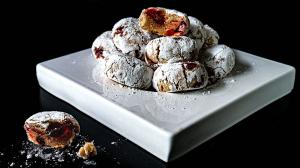The Orthodox Easter festivities this year are exactly one week after the Catholic and Protestant Easter holidays, so I thought I’d post a recipe for these cookies today, on this first Easter Monday, when most of you will be officially on holiday from work and school, instead of waiting until next weekend ! There are so many variations to this recipe but this version is simple to understand, to make, to shape, to bake, to remember and to even modify.
This version is my mother’s «KOULOURAKIA» recipe that I somewhat combined and modified because she has at least 3 or 4 different koulourakia recipes. Some are for crunchier cookies and require butter and make a denser cookie dough and the other ones are for much softer and cakier cookies, and require vegetable shortening or oil and make a less dense cookie dough that requires more eggs and more milk.
The flavorings are always the same using vanilla and orange zests and sometimes lemon zests, but I always add some lime zests too. Some folks like to add a pinch of ground clove or cinnamon and sometimes crushed masticha resin crystals and ground mahleb cherry pit powder too, but I like to reserve these extra flavorings for my Easter TSOUREKI aromatic sweet breads/dense brioches (see my recipe here).
For the level of sweetness of these cookies, many people use less sugar, down to half as much, which is fine for an everyday cookie with coffee or tea, to be enjoyed all year long, but for the Easter holidays, I prefer a sweeter cookie, as is indicated in this recipe.
I don’t add any orange juice to the recipe, simply because I chill the dough several times and the acidity of the juice will react too quickly with the baking powder, even before the actual baking and will diminish its rising effect. In the past, before baking powder, people used a combination of baking soda and baking ammonia, which gave the cookies a particular sharpness and aroma and some people often make a batch of these too, to recall that simpler past.
Usually, to shape the cookies, you make small balls with approximately 2-3 tbsp or 45 grams of dough and then roll them out into ropes and then you start spiraling or braiding them and the end result is very rounded cookie shapes. I do away with that and simply slice them into long strips and then roll them up, which is faster, easier and each cookie looks and weighs the same and has a sharper-edged geometric look.
Larger spirals or snail-shapes are my favorite, but many often make braids as well as smaller S-shaped double spirals. I simply like how the spirals break apart cleanly when you eat them.
You’ll notice when you read the recipe that the required quantities are easy to remember and this recipe is technically a half dose of what people usually make, since people usually make double, starting with 1 kg of flour, but it’s easier for me to make the half dose to make 1 rectangle of dough and slice it into 25 strips and roll them up into 25 cookie spirals. Otherwise, I would simply double the recipe, shape 2 rectangles of dough and create 50 strips of cookie dough for 50 cookies.
For those of you, like my dad, who prefer much softer, cake-like and less crunchy koulourakia cookies, then feel free to double the quantity of eggs to 250 grams and double the milk too to 125 grams, add 50 grams more sugar and ½ tsp more baking powder and you can replace the butter with vegetable shortening or chilled vegetable oil. The rest of the aromatic ingredients remain the same, the dough will be softer and will require longer chilling periods and perhaps just a little more flour (up to 4 tbsp) if it’s too soft, but you’ll understand when and if you choose this option. These cookie recipes are quite forgiving but I prefer the slightly softer on the inside and crunchier on the outside version, just like in my recipe here.
Happy Catholic and Protestant EASTER Monday holiday to many today and Happy Orthodox EASTER to some the upcoming next weekend … :)

















